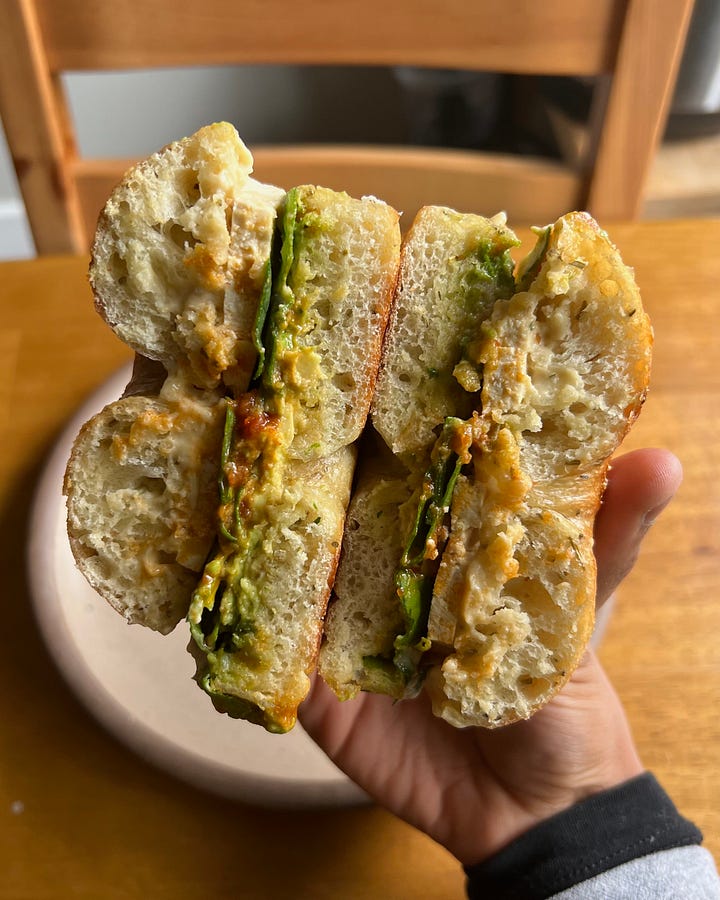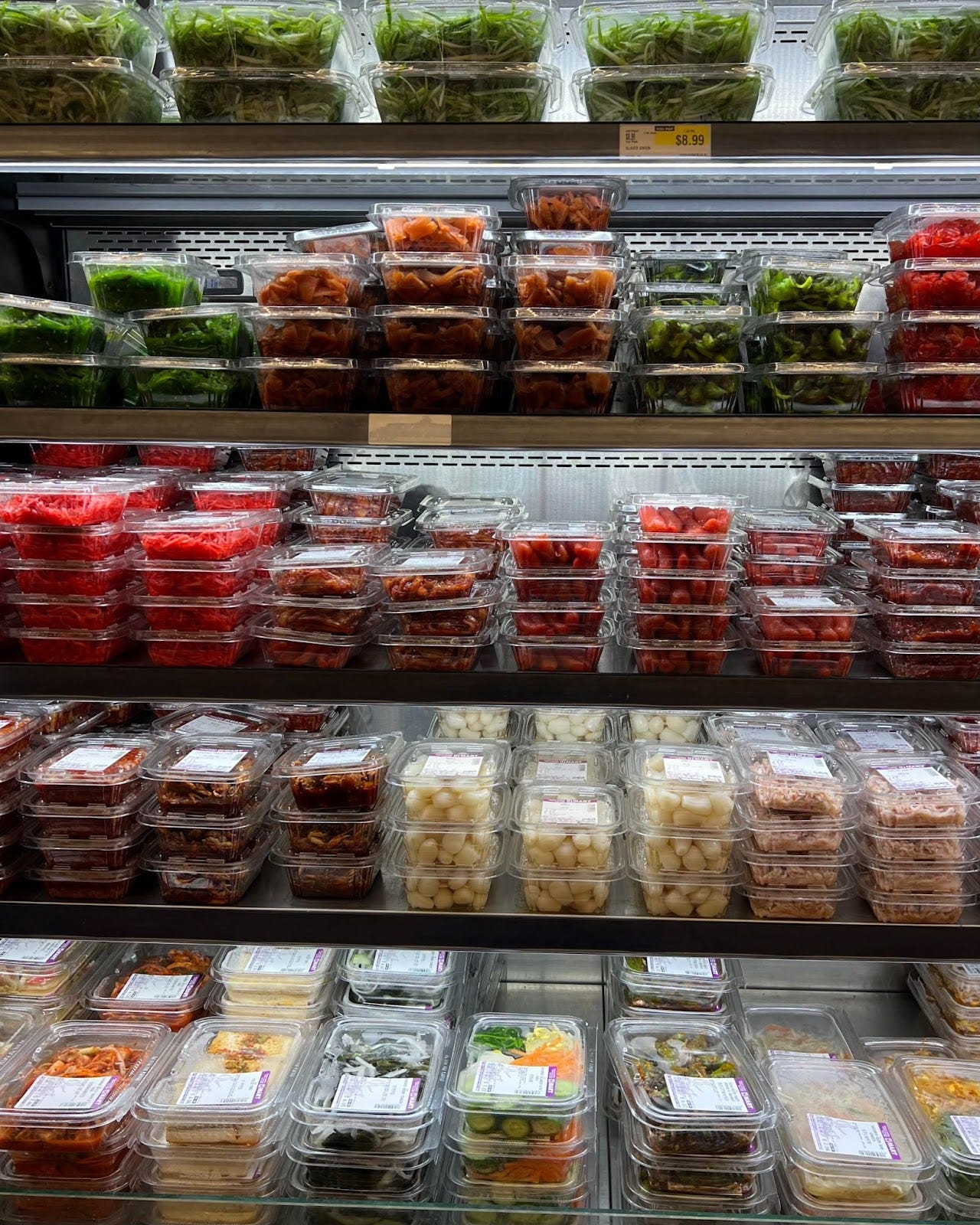I take the bus to Koreatown every Wednesday morning. The 720 cruises down Wilshire, past hotels in Beverly Hills, minimalistic boutiques in Melrose, and tourists posing with the LACMA lamp posts. It takes an hour to inch 8 miles, but I’ve learned to convince myself that it’s worth it, especially if I get a huge bag of bok choy or some vegan kimchi at H Mart at the end of it. Throughout the bumpy ride, people change, shops change, restaurants change. The dichotomy between each neighborhood feels very LA.
At the organization I intern with in Koreatown, we recently introduced incentives to attend nutrition classes, like passes to skip the line at the food pantry and gift bags with kitchen tools. I haven’t been with the organization for long, but something tells me that if we have to bribe people to attend nutrition classes, it's possible that they don’t want or need them. It’s possible that we need to rethink our role in their community.
In middle school and high school, I remember being constantly rewarded for volunteering. It didn’t matter what you were volunteering for; if you were volunteering at all, you were being helpful. If you racked up enough community service hours, you received certificates and medals and compliments from your parents’ friends at Diwali parties. My middle school friends and I scoured swamps for trash, wrapped presents at the mall, went trick or treating to fundraise for global charities, and lifted crates of canned beans at food banks. I’m not saying that none of this was helpful. We were pre-teens desperate to make a difference, we had fun doing it, and we learned from our experiences. Still, we volunteered without thinking much about why the organization existed in the first place and what its role was in the broader system.
Take food pantries, for example. They tend to serve people who either cannot afford quality food or people who live in areas with a lack of grocery stores. Some food pantries’ may have an extraordinary impact, but these organizations often neglect to contest the systems that create food insecurity. Many pantries take a food security approach rather than a food justice approach, which is an important distinction to make. In Rebecca De Souza’s book, Feeding the Other: Whiteness, Privilege, and Neoliberal Stigma in Food Pantries, she argues that food pantries emphasize individual responsibility for acquiring food, rather than food justice and equity.
“Food pantries—run by charitable and faith-based organizations—rather than legal entitlements have become a cornerstone of the government's efforts to end hunger…It is only by rejecting the neoliberal narrative and giving voice to the hungry rather than the privileged, de Souza argues, that food pantries can become agents of food justice.”
A similar trend takes place in nutrition education, where “food is medicine” initiatives overshadow broader systems-level changes in a way that may be paternalistic (Barnidge et al.). These initiatives may make assumptions about what people know and insert themselves in communities by offering educational programs. As defined in “Identifying and Countering White Supremacy Culture in Food Systems”:
“Paternalism involves interfering in an individual’s or community’s ability or opportunity to choose and make decisions…In the food space, paternalism focuses on the belief that BIPOC communities cannot take care of themselves and need solutions prescribed to them.”
In food banks, schools, and farmers markets, the mere existence of nutrition classes highlights the individual’s lack of knowledge and the need for education, instead of addressing structural issues like access and affordability. This feeds into the “If they only knew” narrative, which focuses on the individual’s need for education through nutrition and cooking classes. For example, the SNAP-Ed program aims to teach SNAP participants about nutrition and physical activity, potentially disregarding what participants already know and failing to address “larger structural forces that can impact healthy behaviors” (Conrad). Notably, the organization hosting the classes gets to decide what counts as “good food,” which often falls in line with Eurocentric standards of healthy eating and ignores what community members actually want to eat.
An analysis called “Knowing ‘Good Food’: Immigrant Knowledge and the Racial Politics of Farmworker Food Insecurity” examines the limitations of nutrition education with a focus on immigrant farmworkers, many of whom grew up with a deep connection to their culture’s food and agricultural practices, yet in America, they are often treated as if they don’t know “good” food (Minkoff-Zern). Due to their inability to afford nutritious foods, they may participate in programs targeted at food insecure populations, yet these programs operate with the assumption that lack of knowledge is the main barrier to healthy eating. The problem isn’t necessarily the mindsets of individual educators, but rather that these programs are structured in a way that gives educators limited tools to address structural barriers to food. Minkoff-Zern also discusses the intersection of non-white immigrant food cultures and nutrition:
“The assumption that low-income people are lacking nutritional knowledge intersects with racial constructions that reinforce disparaging attitudes concerning people of color and their ways of being…In the context of this study, food assistance workers have interpreted immigrant foods as unhealthy and even unclean, reflecting the lack of understanding of immigrant foodways.”
This brings me to the controversy at the heart of this: do we continue to make the flyers and teach the classes the usual way, knowing that it will probably have a positive impact on a few people? Or is “lack of knowledge” not a worthy barrier to focus on when so many studies have shown that access and affordability are more significant barriers?
Personally, I think there’s room for nutrition education when executed in a way that builds community, centers cultural humility, and avoids paternalistic attitudes. Nutrition education can be a small part of a bigger picture that includes engaging with the structures that prevent access to healthy food in the first place. Guides for nutrition educators should acknowledge the power dynamics involved in nutrition education and instruct educators to respectfully interact with their clients, yet currently, all you can find in the FDA’s Health Educator Nutrition toolkit is a heavy emphasis on reading nutrition labels and understanding which terms (i.e. fried vs. roasted) are associated with fewer calories! I’m not familiar with other training materials, but I hope there’s more to it.
For now, I’m continuing to work with my current organization. From what I’ve seen so far, the few people who attend nutrition classes pay close attention and share what they know just as much as we share what we know. My organization is specific to people with certain health conditions, and many of them appreciate having access to nutrition counseling and classes that provide a space for people to gather and get to know one another. While I don’t agree with everything I’ve observed in the past few months, it has still been a valuable learning experience for this unpaid intern!
Works Cited and More Resources:
Alkon, A. H., Block, D., Moore, K., Gillis, C., DiNuccio, N., & Chavez, N. (2013). Foodways of the urban poor. Geoforum, 48, 126–135.
Barnidge, E. K., Stenmark, S. H., DeBor, M., & Seligman, H. K. (2020). The Right to Food: Building Upon “Food Is Medicine.” American Journal of Preventive Medicine, 59(4), 611–614. https://doi.org/10.1016/j.amepre.2020.04.011
Burt, K. (2021). The whiteness of the Mediterranean Diet: A historical, sociopolitical, and dietary analysis using Critical Race Theory. Journal of Critical Dietetics, 5(2), Article 2. https://doi.org/10.32920/cd.v5i2.1329
Conrad, A. (n.d.). Identifying and Countering White Supremacy Culture in Food Systems. World Food Policy Center. Retrieved February 5, 2023, from https://wfpc.sanford.duke.edu/reports/identifying-and-countering-white-supremacy-culture-in-food-systems/
Minkoff-Zern, L.-A. (2014). Knowing “Good Food”: Immigrant Knowledge and the Racial Politics of Farmworker Food Insecurity. Antipode, 46(5), 1190–1204. https://doi.org/10.1111/j.1467-8330.2012.01016.x
Souza, D., & T, R. (2019). Feeding the Other: Whiteness, Privilege, and Neoliberal Stigma in Food Pantries. https://doi.org/10.7551/mitpress/11701.001.0001
On my first bus ride to Koreatown, I read Anjali’s essay “Teaching Poor People About Food Is Not the Answer” on her Substack, Antiracist Dietitian. It definitely influenced how I approached my internship!
mini spice rack
eating
Back on my Sunday bagel kick, kimchi jjigae from The Korean Vegan’s cookbook, not one but TWO different bhajis (my mom’s frozen bhaji and my roommate’s mom’s frozen bhaji – we’re very lucky), sattu paratha, and lots of shishito peppers.


drinking
I had an orange cardamom latte at a coffee shop, which sounded great but it was actually ok so I tried making my own. Brew some coffee and seep an orange peel in it. With ½ cup milk of choice, blend 2 cardamom pods, 1 medjool date, splash of vanilla extract, 2 tbsp freshly squeezed orange juice (from a quarter of an orange or so), ½ tsp orange zest. Use that as the milk for your latte.
reading
The viral “Life After Food?” essay on Ozempic by Matthew Schneier for The Cut… Mostly stuff for school though. It’s my last week!
listening
Two songs: American Teenager by Ethel Cain and Moves by Suki Waterhouse. I’m sure we are all aware from the headlines that Stanley Tucci made Ina Garten her first martini, but yeah, that too.





urban gardens + community-focused culinary education for the win <3
Some powerful connections you’ve made in your unpaid internship. I currently work in a setting that is all about nutrition education/lifestyle changes and it’s been challenging to communicate this information that avoids a lot of the pitfalls you mentioned. Partly I think because of the system I operate in and for a variety of other reasons. It made me think about why the few folks that do attend and that it could be performative wellness. That could be a dangerous assumption I’m making. I just think back to my experiences working in these settings and how performing wellness afforded these people privileges they previously couldn’t. I want to believe that nutrition education still has a small part to play but I think it would have to function radically different than it currently does in many institutions. It almost feels like to be able to innovate this would have to be outside of these institutions. Are there spaces, places or works from others etc. that you find inspiring when it comes to how nutrition education could be different and reaches the themes you outlined? Would love to dream with others to help stimulate my own ideas and hopefully towards implementation.